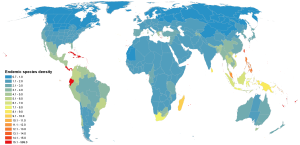A newly published study shows that most of Earth’s plant biodiversity can be preserved through highly targeted conservation, amounting to 17% of all land.
The research drills down to identify the most crucial regions to protect that contain the most plant species. Not surprisingly, protecting those areas would do the same for birds, mammals and amphibians that also have small ranges.
"The variety of life on Earth is not spread evenly, but is concentrated in very special places," says Clinton Jenkins, a scientist at North Carolina State University. "Nearly two-thirds of the world’s plants occur on just 17% of the world’s land. The bad news is that less than a sixth of that 17% is currently protected," says a blog on Saving Species.
"Our analysis shows that two of the most ambitious goals set forth by the 2010 Convention on Biological Diversity – to protect 60% of Earth’s plant species and 17% of its land surface – can be achieved" notes Stuart Pimm, professor of conservation ecology at Duke’s Nicholas School of the Environment.
This map shows critical areas for plant protection, the one below it shows the same for animals.


Published in Science, the study is a collaboration among scientists at Duke, North Carolina State University and Microsoft Research. Using computer algorithms, they honed in on the smallest amount of land necessary to protect the most species.
More land needs to be protected at a faster rate to protect two-thirds of the world’s plant species, particularly in areas such as Madagascar, New Guinea and Ecuador – all of which face significant threats. Other areas are Colombia and coastal Brazil.
Plant species aren’t haphazardly distributed across the planet, researchers say. Some areas have much higher concentration of endemic species (only found there) than others: Central America, the Caribbean, Northern Andes and regions in Africa and Asia.
"Species endemic to small geographical ranges are at a much higher risk of being threatened or endangered than those with large ranges," explains Lucas Joppa, conservation scientist at Microsoft Research’s Computational Science Lab in the UK. "We combined regions to maximize the numbers of species in the minimal area. With that information, we can more accurately evaluate each region’s relative importance for conservation, and assess international priorities accordingly."
The result of the research is a color-coded global map that shows high-priority regions, ranked by the density of endemic species.
"The fraction of land being protected in high priority regions increases each year as new national parks are established and greater autonomy is given back to indigenous peoples to allow them to manage their traditional lands," says Pimm, who also leads and founded the nonprofit, Saving Species, which works to protect biovdiverse land. "We’re getting tantalizingly close to achieving the Convention of Biological Diversity’s global goals. But the last few steps remaining are huge ones."
Restoring the economy’s natural support systems – reforesting the earth, protecting topsoil, restoring rangelands and fisheries, stabilizing water tables, and protecting biological diversity- would cost just $110 billion a year, says Lester Brown in his latest book, World on the Edge.
Here is the Saving Species website:
